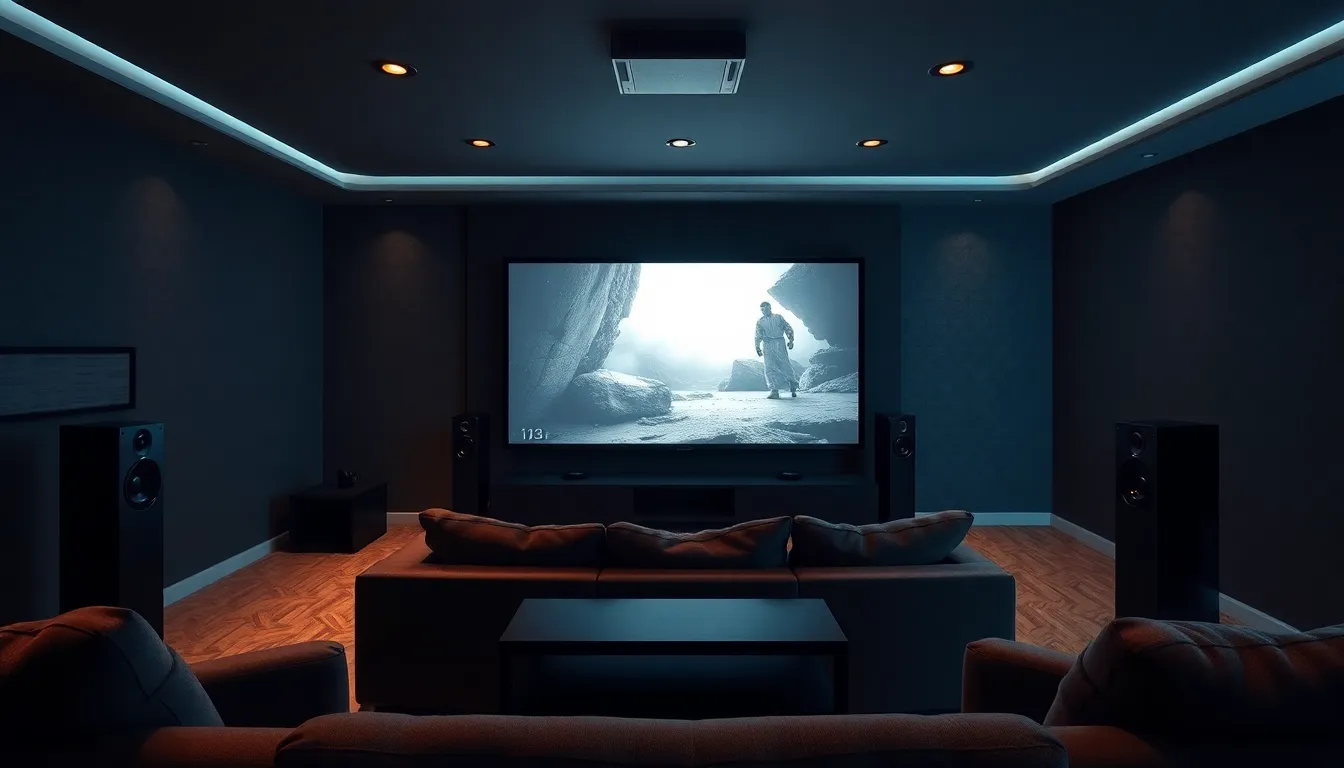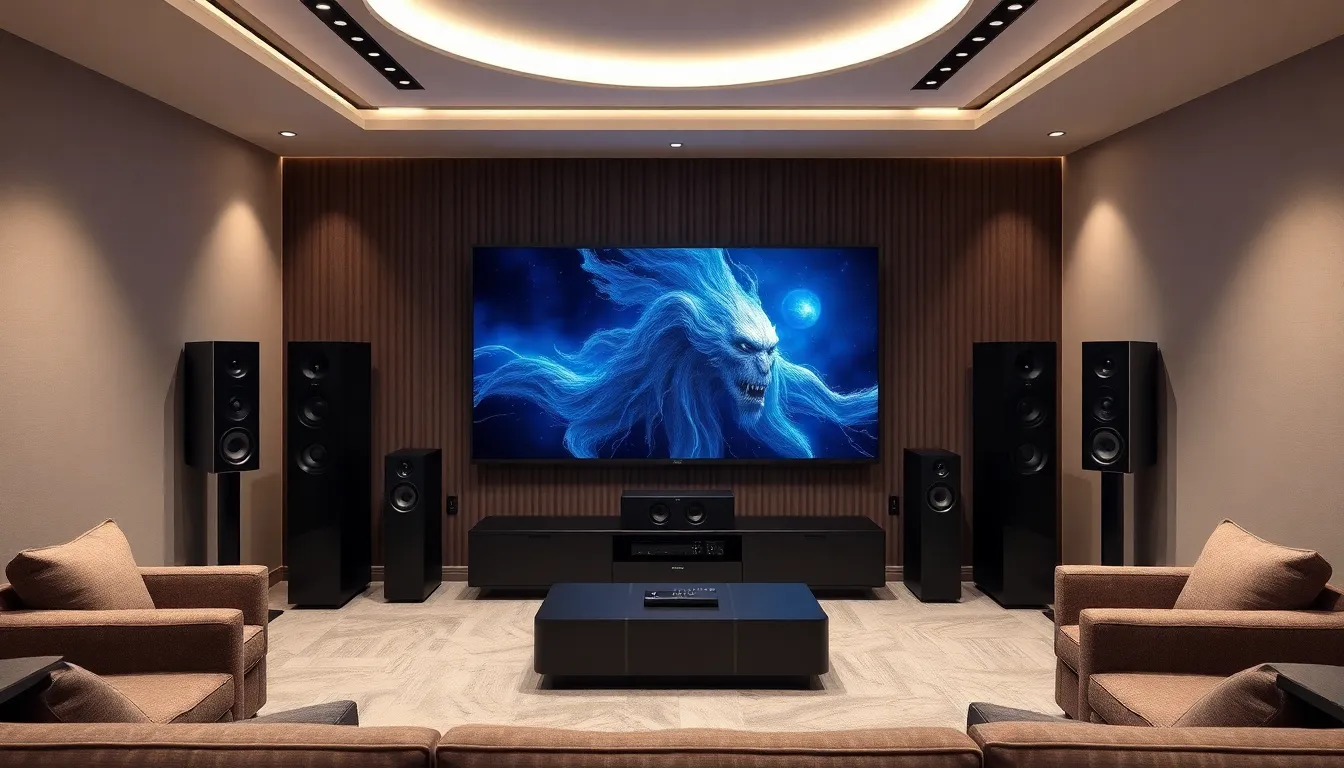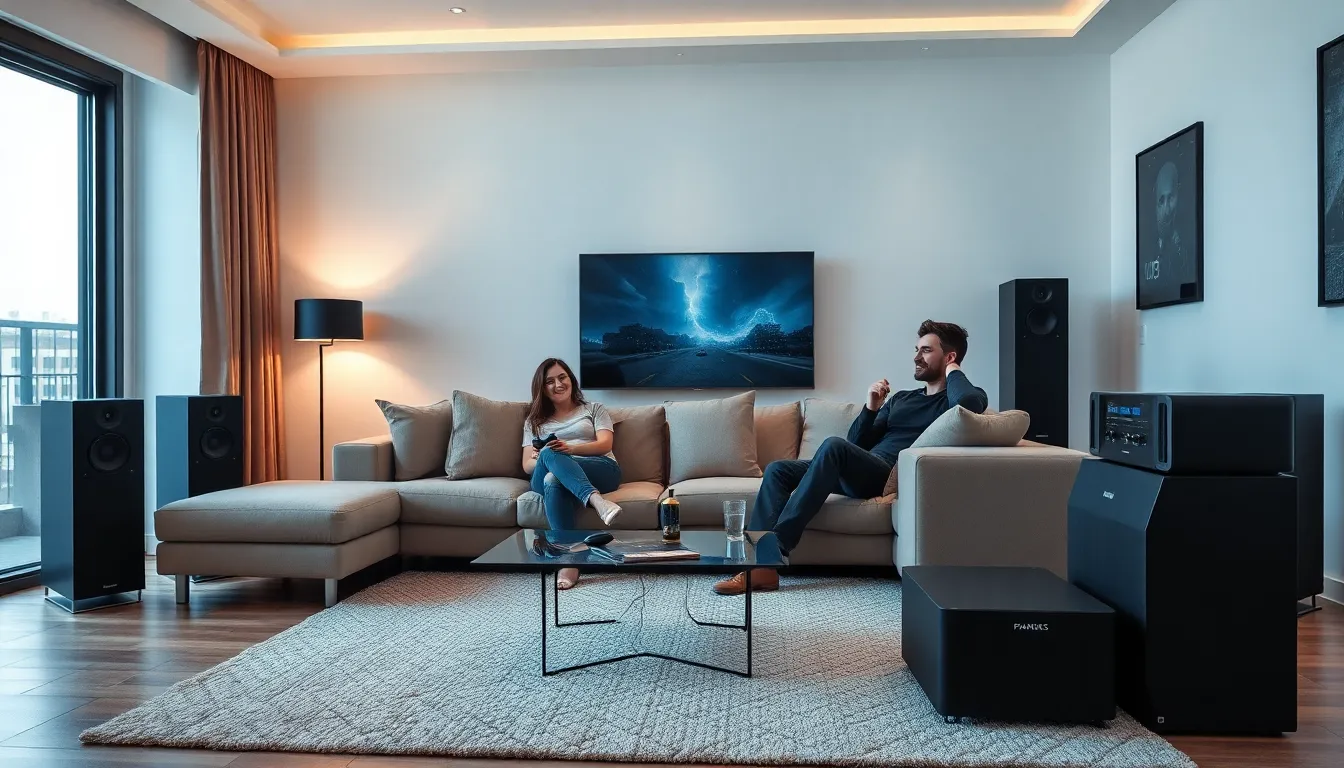Surround sound systems have revolutionized the way people experience audio, transforming ordinary movie nights and gaming sessions into immersive adventures. With the right setup, sounds can envelop listeners from all directions, creating a lifelike atmosphere that draws them deeper into the action.
As technology advances, options for surround sound systems continue to expand, catering to diverse preferences and budgets. From sleek soundbars to intricate multi-speaker configurations, there’s a solution for everyone looking to enhance their audio experience. This guide explores the essentials of surround sound systems, helping enthusiasts make informed decisions and elevate their home entertainment to new heights.
Table of Contents
ToggleOverview of Surround Sound Systems
Surround sound systems replicate audio in a way that engages the listener from multiple angles. These systems enhance audio experiences by producing sound from various directions, creating an immersive environment. Options include:
- Soundbars: Compact solutions that simulate surround sound using fewer speakers.
- Home Theater Systems: Multi-speaker setups that consist of front, rear, and subwoofer elements, offering a rich audio landscape.
- Receiver Components: Central units that process audio signals and manage speaker outputs, ensuring optimal sound quality.
Surround sound formats enhance television and film experiences, with popular configurations such as 5.1 and 7.1 channel systems. The numbers indicate the number of speakers and subwoofers, respectively. For example, in a 5.1 setup, five speakers deliver audio, while one subwoofer handles bass.
Additionally, advancements in technology include wireless surround sound systems, which eliminate the need for extensive wiring. These systems maintain sound quality while providing flexibility in speaker placement.
Surround sound systems support various audio formats, including Dolby Digital and DTS. These formats expand the soundstage, making audio playback more dynamic and lifelike. By selecting the appropriate system, users enhance their entertainment experience based on room size and personal preferences.
Types of Surround Sound Systems


Several types of surround sound systems cater to different audio experiences. Each system offers unique features tailored to enhance enjoyment during movie nights and gaming.
5.1 Surround Sound
5.1 surround sound systems consist of six channels: one subwoofer and five speakers. The configuration includes a center speaker for dialogue, front left and right speakers for sound imaging, and surround left and right speakers to create an immersive environment. This setup offers a balanced audio experience, making it ideal for home theaters. 5.1 systems support formats like Dolby Digital, providing clear and impactful sound for a range of media.
7.1 Surround Sound
7.1 surround sound systems expand on the 5.1 setup by adding two additional speakers, enhancing depth and location accuracy in audio playback. These systems include all the components of a 5.1 system while adding rear surround speakers that improve sound directionality. This setup is well-suited for larger rooms and offers a more enveloping audio experience, particularly beneficial for action films and immersive gaming. 7.1 systems often support advanced audio formats and deliver richer sound profiles.
Dolby Atmos
Dolby Atmos represents an advanced surround sound format that adds a vertical dimension to audio. This system incorporates overhead speakers or upward-firing speakers, creating soundscapes that seem to flow above the listener. Dolby Atmos systems allow sound designers to pinpoint sounds in three-dimensional space for a more realistic audio experience. This technology is compatible with various speaker configurations, including 5.1 and 7.1 setups, and works seamlessly with compatible media, enhancing overall entertainment value.
Features to Consider
When selecting a surround sound system, several key features impact audio performance and user experience. Understanding these features helps individuals make knowledgeable choices.
Audio Quality
Audio quality represents a crucial element in a surround sound system. High-definition formats, such as Dolby Atmos and DTS:X, provide superior clarity and immersive sound. Systems designed with superior speakers, capable of reproducing a full frequency range, deliver a more accurate auditory experience. Shelling out for a model with high power output and low distortion rates ensures a rich soundscape that elevates movies and gaming.
Connectivity Options
Connectivity options play a significant role in usability. Look for systems equipped with multiple HDMI inputs to accommodate various devices, like Blu-ray players, gaming consoles, and streaming devices. Wireless technologies, such as Bluetooth and Wi-Fi, facilitate convenient streaming without excessive cabling. Systems supporting both optical and AUX inputs add versatility for connecting additional devices.
Design and Aesthetics
Design and aesthetics influence how a surround sound system integrates within a living area. Sleek designs and customizable finishes allow for a cohesive look that complements existing decor. Compact soundbars and ceiling-mounted speakers save space without sacrificing performance. Choosing systems that blend seamlessly with furniture enhances both functionality and visual appeal.
Popular Brands and Models
Several brands dominate the surround sound market, each offering distinct models tailored to different audio needs and environments.
Bose
- Bose Soundbar 700: This sleek soundbar provides excellent sound quality and features voice control compatibility.
- Bose Lifestyle 650: A full surround sound system with six speakers, ideal for immersive audio in spacious rooms.
Sonos
- Sonos Arc: This high-end soundbar supports Dolby Atmos, delivering impressive surround sound with minimal clutter.
- Sonos Playbar: An effective option for users seeking a balance between performance and price, enhancing TV audio effortlessly.
Yamaha
- Yamaha YAS-209: A budget-friendly soundbar that offers good performance along with built-in Amazon Alexa for smart functionality.
- Yamaha RX-V685: A versatile AV receiver that supports multiple speaker configurations, including 7.1 setups, appealing to both casual and serious audiophiles.
LG
- LG SN11RG: This soundbar integrates upward-firing speakers for a 7.1.4 surround sound experience, enhancing movie nights significantly.
- LG SK10Y: An affordable model featuring DTS:X and Dolby Atmos, providing great audio for varied content types.
Samsung
- Samsung HW-Q950A: An advanced soundbar system with wireless rear speakers, supporting both Dolby Atmos and DTS:X for an immersive surround experience.
- Samsung HW-N950: A popular choice for home theaters, known for its exceptional sound quality and design.
Klipsch
- Klipsch Reference Premiere 5.1.2: This surround sound system combines powerful speakers with Dolby Atmos for an elevating audio experience.
- Klipsch Black Reference Theater Pack: Compact satellite speakers ideal for smaller spaces, providing robust sound without compromising performance.
Denon
- Denon AVR-X3700H: A feature-rich AV receiver with multiple HDMI inputs, supporting 9.2 channel surround sound configurations, suitable for advanced setups.
- Denon DHT-S216: A soundbar with subwoofer that offers easy connectivity and solid performance at an entry-level price point.
These brands and models represent a range of options tailored to varying preferences and budgets, allowing users to create optimal audio environments in their homes.





